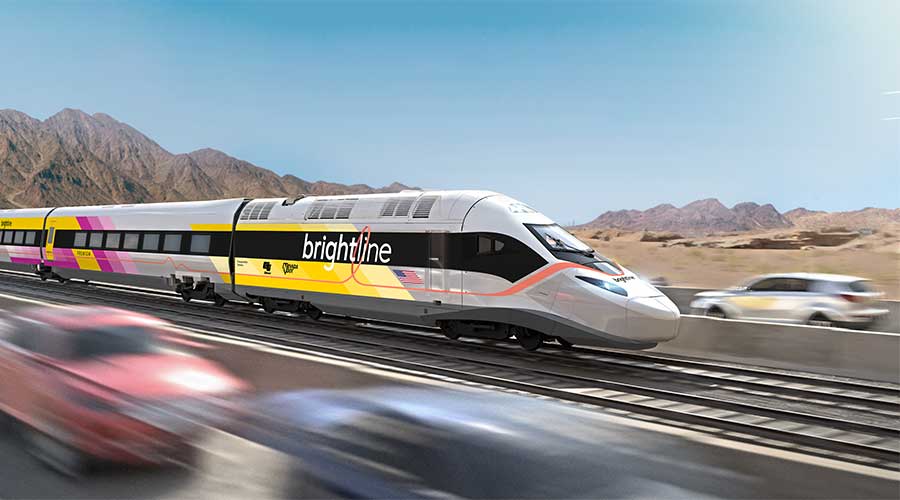Stay updated on news, articles and information for the rail industry
August 2011
Rail News: Passenger Rail
Streetcar builders see potential in North American market
By Julie Sneider, Assistant Editor
Energy efficient. Low-floor accessibility. No overhead wires. A sleek, modern style resembling a light-rail train.
In a nutshell, those are some of the modern streetcar design characteristics that transit agency officials in many North American cities are interested in, streetcar builders say.
Although the North American streetcar market currently is relatively small, interest in exploring streetcar systems is growing, and builders are monitoring that interest. According to the American Public Transportation Association’s (APTA) Streetcar Subcommittee website, business and community leaders in at least 80 U.S. and Canadian cities are exploring or planning systems.
One of the more recent North American cities to take the streetcar plunge is Atlanta, where the Metropolitan Atlanta Rapid Transit Authority (MARTA) in May awarded a contract to Siemens to supply four S70 streetcars.
The S70 is a modified light-rail platform that Siemens developed for use in Salt Lake City and San Diego, but customized for use in Atlanta, says Paul Grether, manager of streetcar development for MARTA.
An Impressive appearance
MARTA and city officials liked the vehicle’s “very refined design” and modern streetcar appearance, he says. They also were interested in the S70’s partially low-floor (70 percent) accessibility, which makes it easier for riders to board and disembark quickly — a key design element for passengers with mobility issues, as well as for the city’s growing population of bicycle enthusiasts who use public transit intermittently, Grether says.
The S70 streetcars are slated to begin operating through Atlanta’s downtown, business, tourism and convention corridor in 2013. Last month, the Federal Transit Administration announced $47.6 million in TIGER II grant funding was available for work to begin on the $70 million project, which will connect with MARTA through a stop at the Peachtree Street station entrance.
Atlanta’s car is being designed for single-vehicle operation, “with a passenger area optimized for speedier entry and exiting, yet providing plenty of seating for those passengers traveling longer distances,” said Robin Stimson, vice president of business development, mobility division for Siemens Industry Inc.
“The vehicles will include a load-leveling system to automatically adjust the door threshold height to the platform curb,” Stimson said in an e-mail interview. “The vehicles will also have the ability to incorporate deployable bridgeplates to accommodate very low platforms in the future, if desired.”
Atlanta’s streetcar project is one of four currently under construction in the United States and Canada, according to the APTA Streetcar Subcommittee’s website. Another project is under way in Toronto, where Bombardier Transportation won a $1.2 billion contract in 2009 to provide 204 of its low-floor Flexity light-rail vehicles to replace the city’s streetcar fleet, which was built in the 1970s and 1980s. The new cars, which will be adapted to operate on the city’s existing streetcar network, are slated for delivery starting in 2012.
The streetcars will be five-module, uni-directional vehicles with all-wheel drive; stretech more than 28 meters long and 2.54 meters wide; include a step-less interior to ease access from the street level; offer passenger conveniences such as room for wheelchairs, bicycles and strollers; and feature an energy-saving regenerative braking system, according to literature on Bombardier’s website.
Meanwhile, Bombardier is finalizing a common streetcar platform specifically for use in North America, says Jacques Drouin, the company’s senior specialist in product management. The 100 percent low-floor design will be a key feature for the U.S. market, he says. At 2.65 meters, the vehicle will be a bit wider than the typical U.S. streetcar and will be available in three lengths.
Going wireless
Also increasingly popular in the design realm is a streetcar that can operate without the need for overhead electrical wires, Drouin says.
Bombardier is developing its PRIMOVE technology system, which would enable Flexity streetcars and light-rail vehicles to run on catenary-free track. As described on Bombardier’s website, the PRIMOVE system’s electric supply components are hidden under the vehicle and beneath the track. Connected to Bombardier’s MITRAC Energy Saver system, the PRIMOVE stores energy during braking and charges during operation, “picking up power from the underground section during catenary-free operation.”
Streetcars capable of operating on and off wire are of particular interest in cities where local officials want to preserve a wire-free view in historic districts, as well as in communities seeking to save money on infrastructure costs, says Bill Kleppinger, program manager for Kinkisharyo International L.L.C., which earlier this year unveiled the prototype for its new, 100-percent low-floor ameriTRAM™ streetcar.
Designed specifically for the North American market, the ameriTRAM features an “e-BRID™ propulsion technology” that enables the vehicle to be powered by overhead catenary or onboard lithium-ion batteries, says Kleppinger. The technology charges the batteries while the streetcar runs on catenary power. When in battery mode, the e-BRID uses electricity stored from regenerative braking.
“This gives the vehicle the opportunity to run under a normal catenary system or to run off wire for up to four miles, depending on the system alignment and number of stops,” Kleppinger says. “It enables the system to be more environmentally responsive and sustainable because, potentially, it can use less energy. It also allows a municipality to look at lower infrastructure costs to support the system. If you’re not running on wire, the energy usage could be reduced, which is also saving the municipality money and helping the environment.”
Kinkisharyo recently tested the ameriTRAM in Charlotte, N.C., and Dallas, and plans to display it in a number of U.S. cities during the summer, as well as at the APTA Expo 2011 in New Orleans in October.
United Streetcar officials also have taken note of the growing interest in wireless streetcars. The Portland, Ore.-based company — the only U.S.-based modern streetcar manufacturer, according to the company — currently offers two streetcar models and is developing a third that would have the potential to run on a wireless system.
The company’s offerings include the United Streetcar 100, the baseline model now in operation in Portland. It’s the longest-running modern streetcar in the United States, says United Streetcar President Chandra Brown. United Streetcar is building its 200-level model for Tucson, Ariz.’s $148 million streetcar expansion. The 200 model was designed specifically for hot-weather climates. Features include an increased cooling capacity, improved air distribution, solar glass, LED lights inside and out, and a more efficient air conditioning system, Brown says.
United Streetcar’s 300-level model is being developed in response to interest in a wireless option, which Brown described as the “unmet need” in the U.S. streetcar market.
“We’re working on the design of that car now, and hope to build it for a customer within the next year,” says Brown.
Although the market for streetcars remains small in North America compared with, say, Europe, that’s likely to change over time, says Boris Homenock, a Chicago-based consultant to Vossloh North America. The increasing — and in some cases, record-setting — ridership reported by U.S. passenger rail systems has Homenock convinced it’s just a matter of time before the streetcar market takes off.
As a result, Vossloh is “looking to introduce” its TramLink articulated electric streetcar in the U.S. market, Homenock says.
TramLink is a 100 percent, low-floor design with conventional axles. Currently in operation in Europe, the TramLink ranges in length starting at about 69 feet, and can come in various widths up to 2.65 meters. Made of stainless steel, the car’s shape is convex to provide more room for riders, Homenock says. Passenger access is available from both sides of the vehicle, again making it easier for passengers to get on and off board quickly. The basic TramLink is powered by a catenary system but also has the capability of using battery technology to operate “off wire” over certain distances.
Monitoring the market
Alstom planners, too, are keeping a close eye on the North American market. Although the builder doesn’t yet have a streetcar operating in North America, “our current focus is on providing states, cities and other authorities considering streetcar projects with insight into best practices from projects we have supported around the world,” Alstom officials said in a prepared statement.
In response to interest in wireless or in-track catenary systems, Alstom offers its APS system, which the company claims is “the only wireless catenary solution available on the global market that has been extensively tested and proven on existing streetcars.” Alstom also offers the battery technology to enable a streetcar to operate without catenary support over short distances. For example, battery technology was developed on rolling stock for the company’s Citadis streetcars operating in Nice, France.
Although more public transportation officials seem to be interested in sleek, modern European styling, certain cities — San Francisco and New Orleans among them — maintain a vintage or historic design, says Joel McNeil, transportation sales, at Brookville Equipment Corp.
Brookville supplies new and remanufactured cars, but a majority of its streetcar business has been in interior and exterior restoration and refurbishment work, says McNeil. Major projects have included the Southeastern Pennsylvania Transportation Authority; the San Francisco Municipal Transportation Agency, which oversees that city’s historic cable car system; and the New Orleans Regional Transit Authority.
McNeil, who serves on the APTA Streetcar subcommittee, cites increasing attendance at committee meetings as evidence of growing interest in streetcars — the vintage and the modern.
“I would agree that in North America, there’s definitely an understanding of streetcars as a viable mode of public transportation,” he says.
E-mail comments to Julie Sneider, Assistant Editor.


 LRW Honors Amtrak’s Acheson As Railway Woman Of The Year
LRW Honors Amtrak’s Acheson As Railway Woman Of The Year
 From Editor-In-Chief Foran: Of Gender Equity And Inclusion
From Editor-In-Chief Foran: Of Gender Equity And Inclusion
 Spotlight On Some Of Today’s Rail Safety Products
Spotlight On Some Of Today’s Rail Safety Products
 Women of Influence in Rail eBook
Women of Influence in Rail eBook
 railPrime
railPrime








